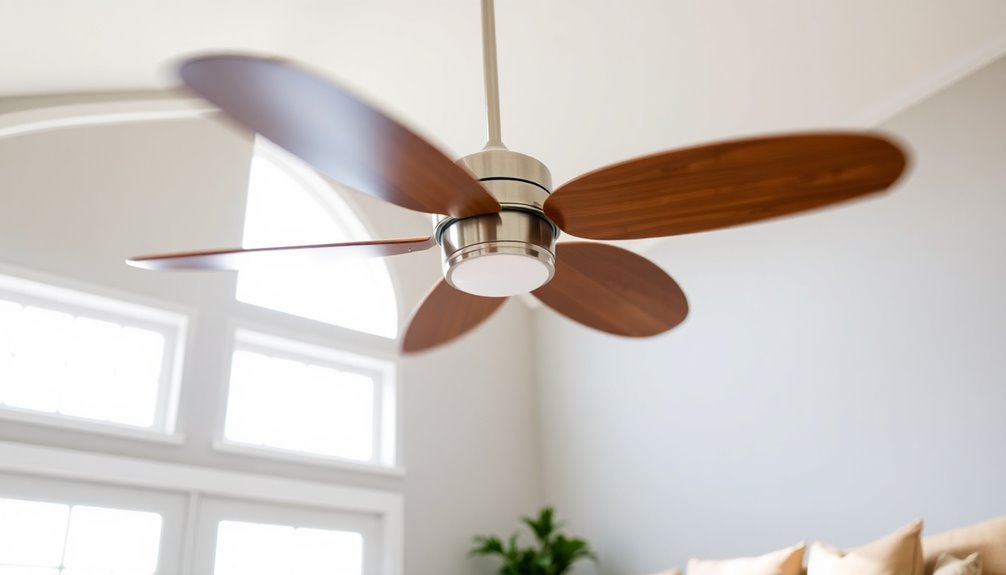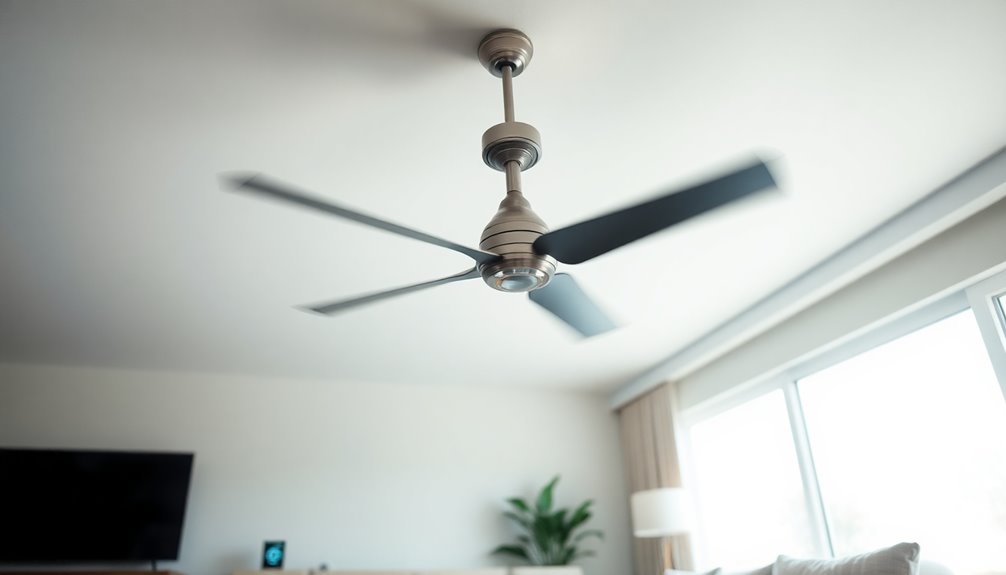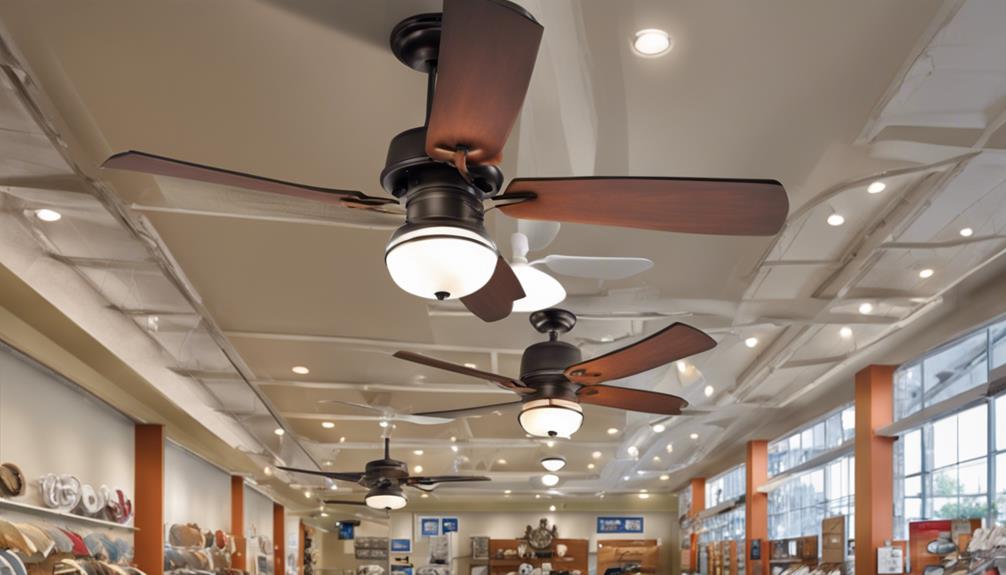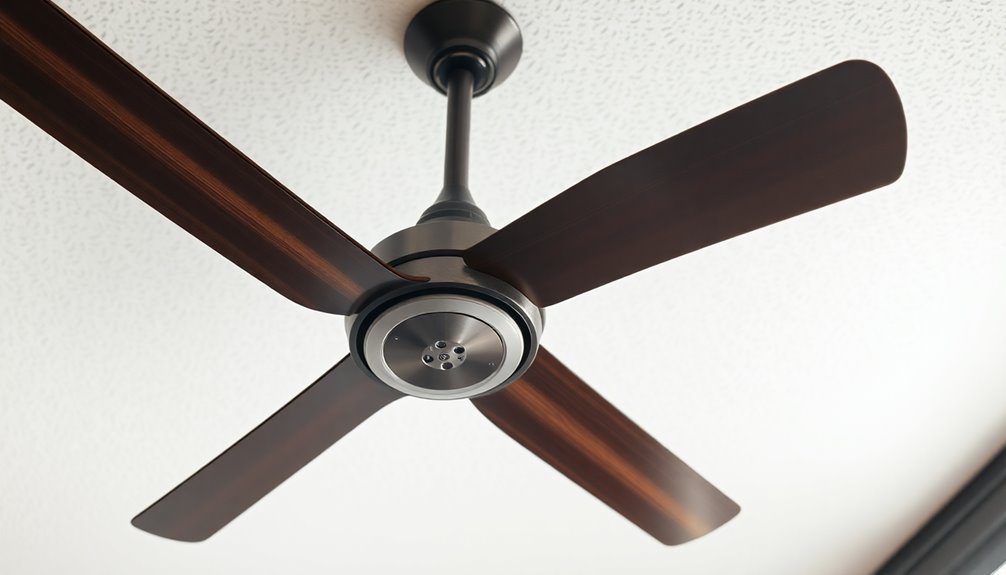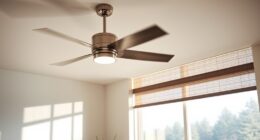Your ceiling fan should spin counterclockwise in the summer to create a cooling breeze, making the room feel up to 8°F cooler. In winter, switch it to clockwise; this helps circulate warm air down from the ceiling, improving warmth without drafts. Remember to adjust the fan direction based on the season for ideal comfort and energy efficiency—this simple change can lower your heating and cooling costs considerably. Don't forget, you can easily adjust the direction using a pull chain or remote. There's plenty more to explore about maximizing your fan's performance and efficiency.
Key Takeaways
- In summer, ceiling fans should spin counterclockwise to create a cooling downdraft and lower perceived temperatures.
- In winter, fans should rotate clockwise to push warm air down and improve heat circulation.
- Adjust fan direction during Daylight Savings Time as a seasonal reminder for optimal comfort.
- For dining rooms and kitchens, use counterclockwise rotation to enhance cooling and air circulation.
- Regularly check and change fan direction based on seasonal needs for energy efficiency and comfort.
Importance of Ceiling Fan Direction

Have you ever considered how ceiling fan direction affects your comfort at home? The way your ceiling fan spins plays a vital role in creating a comfortable environment, especially during the summer.
When you set your fan to rotate counterclockwise, it generates a cooling breeze that can make your space feel up to 8 degrees cooler. This simple adjustment not only enhances your comfort but also boosts energy efficiency by reducing the need for air conditioning.
In winter, switching the fan direction to clockwise is just as important. This setting pushes warm air down from the ceiling, improving air circulation and minimizing heating costs by up to 15%.
If you neglect to adjust the fan direction seasonally, you might experience inadequate cooling or heating, leading to discomfort and higher utility bills.
Seasonal Direction Guidelines

Understanding how to adjust your ceiling fan direction seasonally is key to maximizing comfort and energy efficiency in your home.
During the summer, set your ceiling fan to spin counterclockwise. This creates a downdraft, providing a cooling breeze that can make rooms feel up to 8 degrees cooler. You'll not only enjoy a more comfortable space but also benefit from significant energy savings on air conditioning costs, potentially reducing them by up to 30%.
When winter rolls around, switch the fan to rotate clockwise. This change creates an updraft, circulating warm air that tends to accumulate near the ceiling. By doing this, you can enhance your overall comfort without increasing heating costs, leading to savings of 15% or more.
A handy guideline is to adjust your ceiling fan direction during Daylight Savings Time. When you set your fan to counterclockwise for summer and clockwise for winter, it serves as a seasonal reminder.
Ensuring your fan is set correctly maximizes airflow efficiency, allowing for potential thermostat adjustments and reduced reliance on HVAC systems. With these simple changes, you can enjoy a more comfortable home year-round.
How to Change Fan Direction

Before you change your ceiling fan's direction, make sure to turn it off for safety.
Depending on your fan type, the process can vary, so it's important to identify whether you have a pull chain, remote control, or smart fan.
Let's go through the step-by-step instructions to get it done efficiently.
Safety Precautions First
Changing the direction of your ceiling fan is a simple task, but safety should always come first. Before you attempt to change direction, make certain to turn off the ceiling fan. This not only guarantees your safety but also prevents any accidental injuries.
If you have a pull chain fan, locate the reversing switch on the fan body. Toggle it to the opposite direction, and then turn the fan back on.
For remote-controlled fans, confirm your remote is paired, turn off the fan, and then press and hold the fan button until the light blinks to change direction.
If you own a smart fan, you can adjust its direction using the SIMPLEconnect app or voice commands, but always remember to turn off the fan beforehand.
Regularly checking your fan's direction is vital for maximizing comfort and energy efficiency throughout the year. By following these precautions, you not only enhance your comfort but also make certain that your ceiling fan operates safely and efficiently.
Identifying Fan Types
Ceiling fans come in various types, each with its own mechanism for changing direction. Knowing how to adjust the fan direction is key to maximizing comfort and energy savings.
Here's a quick guide to help you identify how your fan works:
- Pull Chain Fans: For fans with a pull chain, turn off the fan, locate the ceiling fan switch on the fan body, and slide it to change direction. This switch typically allows you to alternate between counterclockwise direction for cooling and clockwise motion for warm air circulation.
- Remote-Controlled Ceiling Fans: If your fan uses a remote, verify it's paired. Turn off the fan, press and hold the fan button until the light blinks, then turn the fan back on to change direction.
- Smart Ceiling Fans: For smart ceiling fans, you can change the fan direction through a compatible app or voice command after turning the fan off.
Always refer to your owner's manual for specific instructions tailored to your fan model. Understanding the best air flow ceiling fans can also aid in selecting an optimal setting for your space.
Adjusting the fan direction not only enhances comfort but can also reduce energy costs throughout the year.
Step-by-Step Instructions
Knowing how your fan operates sets the stage for adjusting its direction effectively.
To change the direction of your ceiling fan, start by ensuring it's turned off for safety. If you have a pull chain fan, locate the reversing switch on the fan body and slide it to the opposite direction. Typically, for summer, you want the blades to turn counterclockwise to help cool the room. For winter, switch it to clockwise to push warm air down, improving comfort and potentially lowering your energy bill.
If you're using remote-controlled fans, make sure the remote is paired. Turn off the fan, then press and hold the fan button until the light blinks, indicating it's ready for a direction change. After this, turn the fan back on.
For smart fans, you can use the SIMPLEconnect app or voice commands—just remember to turn the fan off before making adjustments.
Always consult the owner's manual specific to your fan model, as methods might vary.
With these simple steps, you can easily adjust your ceiling fan to create the perfect room temperature for summer and winter.
Benefits of Correct Fan Direction

Getting the fan spinning in the right direction offers considerable benefits for your home's comfort and energy efficiency.
By adjusting your ceiling fan's direction seasonally, you can enjoy a more pleasant living environment while also saving money on energy bills.
Here are three key benefits of correct fan direction:
- Cooling Effect: In summer, set your ceiling fans to spin counterclockwise. This creates a cooling downdraft effect, making rooms feel up to 8 degrees cooler and reducing reliance on air conditioning.
- Heat Distribution: In winter, rotating the fan clockwise helps redistribute warm air trapped at the ceiling. This can optimize heat distribution and potentially save you up to 15% on heating costs.
- Energy Savings: Correct fan direction can considerably lower energy consumption for heating and cooling systems.
Fans cost just about $0.01 per hour to run, compared to $0.12-$1.13 for air conditioning, allowing for thermostat adjustments without sacrificing comfort.
Regularly changing your ceiling fans direction can enhance air movement, ensuring you stay comfortable year-round while keeping those energy bills in check.
Ceiling Fan Direction by Room

When it comes to ceiling fan direction, knowing the right settings for each room can make a big difference in comfort and air quality.
You'll want to adjust the fan's spin based on the room's purpose and the season to maximize efficiency.
Let's explore the best practices for different spaces in your home.
Room-Specific Fan Settings
In various rooms, the direction of your ceiling fan can considerably impact comfort and air quality. Adjusting the spin according to the room's purpose guarantees ideal air circulation and enhances your living experience.
Here are a few room-specific fan settings to take into account:
- Dining Room: Set your ceiling fan to spin clockwise at medium or low speed. This helps avoid cooling food too quickly while still promoting air circulation, keeping the atmosphere comfortable.
- Home Office: For a more stable work environment, keep the fan on a medium clockwise setting. This prevents papers from blowing around, allowing you to focus on your tasks without distraction.
- Outdoor Spaces: When enjoying warm weather, set your outdoor ceiling fan to counterclockwise at high speed. This direction enhances cooling and helps deter pests, making your time outside more pleasant.
Seasonal Direction Adjustments
Typically, adjusting your ceiling fan's direction with the changing seasons can considerably enhance your comfort at home.
In summer, you'll want your ceiling fan to spin in a counterclockwise motion. This creates a cooling downdraft, making your rooms feel up to 8 degrees cooler thanks to the wind chill effect. Just flip the direction switch to guarantee the fan is spinning correctly.
As winter approaches, it's time to rotate your fan clockwise at a medium speed. This pushes warm air down from the ceiling, improving heat distribution without creating uncomfortable drafts.
For dining rooms, set the fan to spin clockwise at a low speed to keep food warm while still promoting air movement.
If you have vaulted ceilings, it's best to keep the fan set to counterclockwise year-round to avoid any wind chill during the warmer months.
In home offices, a medium clockwise setting maintains a comfortable environment without papers flying around due to excessive airflow.
Additional Tips for Efficiency

To maximize the efficiency of your ceiling fan, it's essential to keep the blades clean and free of dust.
Dust buildup can hinder airflow, making your fan work harder and consume more energy. Regular cleaning not only enhances efficiency but also improves the overall performance of your fan.
Here are three additional tips to boost your fan's efficiency:
- Use the Fan with Your AC: Adjust your air conditioner's thermostat by about 4 degrees while using the fan. This combination can lead to significant energy savings.
- Turn Off When Leaving: Remember, ceiling fans cool people, not rooms. Always turn off the fan when you exit a room to conserve energy.
- Consider Smart Options: A smart ceiling fan with remote control or scheduling features allows you to optimize airflow and direction automatically based on the season, enhancing overall efficiency. Additionally, maintaining air quality in your home ensures that your fan operates effectively without unnecessary strain.
Frequently Asked Questions
How to Tell if a Ceiling Fan Is Spinning the Right Way?
To tell if your ceiling fan's spinning the right way, stand directly underneath it and feel for airflow.
If you sense a cool breeze, it's likely rotating counterclockwise, which is ideal for summer. In winter, the fan should push warm air down, spinning clockwise.
If you don't feel the expected airflow, check the blade movement; if it's not right, use the reversing switch to adjust it accordingly.
How Do You Tell if a Fan Blade Is Clockwise or Counterclockwise?
To tell if a fan blade is spinning clockwise or counterclockwise, stand directly underneath it.
If the blades move to your right, they're rotating clockwise. If they move to your left, they're counterclockwise.
You can also feel the airflow; a strong breeze means it's counterclockwise, while a gentle airflow indicates clockwise.
For a quick check, look for a reversing switch on the motor housing to adjust the direction if needed.
Which Way Should a Ceiling Fan Spin to Cool a Room?
To cool a room effectively, your ceiling fan should spin counterclockwise.
This direction creates a downdraft, pushing cool air down and making the space feel more comfortable. You'll notice a distinct breeze when standing directly beneath the fan.
Is Clockwise Left or Right on a Ceiling Fan?
So, you're standing there, staring at your ceiling fan, like it's an ancient puzzle, and you're wondering, "Is clockwise left or right?"
Well, don't worry! Clockwise is the direction that takes you on a delightful trip from 12 to 6, like a clock hand on a lazy Sunday.
If you're unsure, just remember: when it feels like the air's getting pushed up, you're definitely going right.
Now, go ahead and adjust that switch!
Conclusion
Just like a compass guiding a traveler, the direction of your ceiling fan can steer your comfort throughout the seasons. When it spins counterclockwise, it stirs a invigorating breeze in the heat of summer, while clockwise creates a warm cocoon during winter's chill. By mastering this simple adjustment, you're not just optimizing airflow—you're crafting a home that embraces harmony and balance, where every breath feels just right, much like finding your way on a well-marked path.
